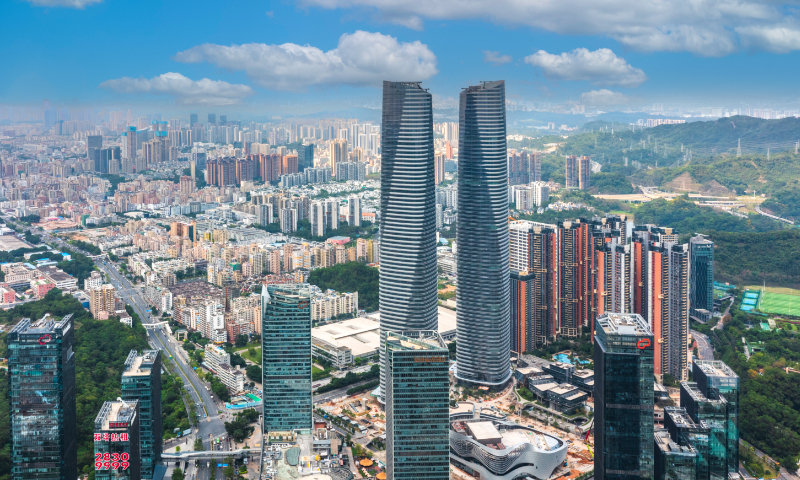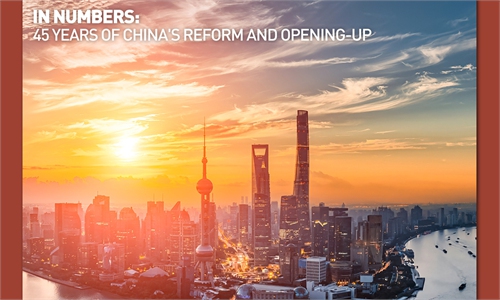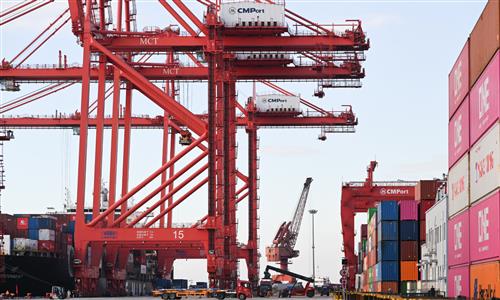
An aerial view of Galaxy Twin Towers in Shenzhen, South China's Guangdong Province on April 30, 2023. Photo: VCG
Editor's Note:
Over the past 45 years of reform and opening-up, China has embarked on a distinctive path toward economic development, achieving remarkable success. Despite the ever-changing international economic landscape and environment, China has achieved significant economic development and contributed to stable and positive forces for global economic growth.
As this year commemorates the 45th anniversary of China's reform and opening-up, Chinese economists noted that amid the growing tide of anti-globalization and protectionism, China's unwavering dedication to deepening reforms and expanding its opening-up will not only foster the high-quality development of its own economy but also enhance economic and trade cooperation with countries including the US. The achievements of China's agenda of reform and opening-up will persist in contributing to the stability of global economic governance.

Cao Heping, an economist at Peking University
In the past 45 years of reform and opening-up, China has made remarkable strides in its economic development. Firstly, China has undergone a significant transition from a resource mobilization-based infrastructure construction national economic system to a processing and manufacturing-based consumption driven economic system.
This transformation has effectively mobilized China's productivity and consumption capacity, the two engines of economic growth. Since the reform and opening-up, the Chinese economy has achieved significant growth. It initially unlocked productivity potential of rural areas, subsequently extending to urban areas and foreign trade resources.
As China achieved global productivity, it gradually accumulated surplus capacity and investment. In order to address the imbalance between effective social demand and supply capacity in certain sectors, China adopted an export-oriented and investment-driven economic model, and then transitioned toward an innovation-driven and consumption-led economy.
Currently, China is accelerating efforts to foster a new pattern of development that is focused on the domestic economy and features a positive interplay between domestic and international economic flows. In terms of macroeconomic management, China has developed a correct path for economic development in response to the global environment.
In light of this aforementioned transformation, the Chinese economy has made significant achievements at almost all industrial levels, with the most significant being the creation of industrial parks. Initially, there were export processing zones, followed by economic development zones, marking a step from coastal areas to inland regions. Subsequently, science and technology parks and industrial parks were developed.
The development of industrial park ecosystems has played a crucial role in transforming the allocation of resources from being solely production-oriented and consumption-oriented to a more balanced domestic and international allocation. Over the past five years, many rural areas have seen the emergence of specialized agricultural and sideline product processing parks, facilitating the development of rural areas and achieving tremendous success.
China's modernization is a comprehensive modernization process that combines a top-down and bottom-up approach. Throughout this process, China has achieved world-class results in terms of technological development, human resource cultivation, and the nurturing of core enterprises.
China initially contributed to the world economy by utilizing cheap labor resources and overseas surplus production capacity. We served as the world's redundant productive force, complementing other countries' surplus capital and technology resources with our surplus labor and market resources.
However, since 2015, China has become the main driving force behind global economic growth, becoming the leading engine. For example, in the clothing and apparel sector, we have consistently produced over 50 percent of the world's share. In sectors such as steel, cement, and other commodities, we are almost always ranked first in the world. China's contribution to global growth, which used to be driven by excess production, has now transformed into a dominant and even primary engine of global economy.
China's growth model and pathway have provided a different modernization process to over 200 countries worldwide, which is distinct from the traditional development economics textbooks. In this industrial production process, per capita resources are not abundant, and the growth model differs from the mainstream Western economies. Additionally, the urbanization process also differs from the description of modernization in economically developed countries outlined by Western economic development theories.
China has gradually demonstrated to countries around the world a path to economic growth for the whole of humanity. In addition to the description of various paths for economic development through the development of a free market, China has a long history of its own national production. Based on its inherent path dependence, China has been able to combine the resource allocation methods of Western development economics to embark on a path of modernization and rapid growth.
Furthermore, as an ancient civilization, China has deep historical understanding. It can rejuvenate, becoming a leader on a new path of development. For example, in recent years, with the support of digital technology, China has far surpassed Japan and Germany in the field of internet-based sharing economy. It is almost on par with the US in this race. Despite the challenges posed by the US, China has not been stifled.
This demonstrates the diversity of cultures and growth models, which should be considered as a reasonable and positive direction for development. It is not true that different cultural beliefs would hinder economic success. I believe that this misconception has been largely debunked.
The US has experienced relatively smooth economic growth. Surprisingly, the US has shifted away from globalization, which had previously been its path to success.
In the past, the US successfully contained challengers like Germany, France, and Japan, and it seemed natural for Washington to also contain China. However, they have taken a stance against globalization, creating their own set of rules by withdrawing from organizations such as CPTPP.
In recent years, China has experienced rapid growth in the steel and cement industries, which has exposed a weakness in the US. However, at this time, the US has adopted a stance of anti-globalization, conservatism, and trade protectionism, which has hindered technological progress. In some cases, the US has even supported regional conflicts, such as the situation in Ukraine. Imperialist countries tend to colonize other nations during times of war, exporting their own economic crises, such as deflation or inflation, to foreign countries. In contrast, China has never pursued colonialism.
Currently, the world is facing a rise in anti-globalization and protectionism. However, China has made further commitments to deepen reforms and expand its openness. China's approach is based on its historical experience, Marxist-Leninist ideology, and the practical experience of the Communist Party of China. This unique path has led to China's promotion of globalization in terms of technology, human resources, and training, and its support for the United Nations system. China's contributions have provided stability and healthy growth to the global governance system.
He Weiwen, senior fellow of the Center for China and Globalization
On December 16, 1978, China and the US released the Joint Communiqué on the Establishment of Diplomatic Relations. Two days later, on December 18, 1978, the Communist Party of China (CPC) convened the third plenary session of the 11th CPC Central Committee, which signaled the beginning of China's reform and opening-up.
These two events were not merely coincidental, but rather had a clear and practical connection. The normalization of China-US relations not only offered a stable international environment for China, but also paved the way for numerous tangible measures aimed at fostering mutually beneficial cooperation.
Joining the World Trade Organization (WTO) was a pivotal and momentous milestone for China's reform and opening-up. During this period, I had the privilege of serving as the Economic and Commercial Counselor at the Chinese Consulates General in San Francisco and New York, where I had extensive engagements with local American authorities and businesses.
During that period, we were primarily focused on two key objectives: fostering the advancement of China-US bilateral relations and analyzing the necessary steps for China to become a member of the WTO. We dedicated significant resources and exerted considerable effort toward these endeavors, recognizing the paramount significance of a robust and harmonious China-US partnership for China's overall progress and reform.
In recent years, the relationship between China and the US has been characterized by tension and discord. However, it is imperative that we make concerted efforts to stabilize this relationship. Following the China-US summit meeting in San Francisco, a glimmer of hope for easing tensions has gradually emerged.
Moving forward, it is essential to prioritize the preservation of China's integration within global supply chains and the continuation of reform and opening-up. These factors will undoubtedly play a pivotal role in shaping the future of China-US relations.
On one hand, the US is reluctant to allow China, with different ideological values, to further its growth and expansion. The US doesn't want to let China's cutting-edge technology affect its hegemony, nor will it permit China's Belt and Road Initiative and other international policies to affect the order led by the US. However, on the other hand, there are still areas of potential cooperation between the two nations.
We should work toward stabilizing tensions, alleviating pressure, and fostering greater cooperation. This requires close collaboration with the American business community, education sector, and civil society. Our endeavors to uphold openness and stabilize the China-US relationship should not solely concentrate on the US government, but also extend to the grassroots level.
Based on my experience working in the US and interacting with state governments and businesses, I strongly believe in the potential for collaboration at the local level. Even if the White House and Congress have their own agenda toward China, it is crucial to foster bilateral cooperation at grassroots and civil levels.
There have been numerous instances where businesses have exerted influence and driven changes. For instance, in the chip industry and other related sectors, local changes were eventually implemented due to the pressure and advocacy from businesses.
Therefore, it is essential to prioritize engagement and collaboration with local governments and businesses community. By doing so, we can address pressing issues and drive positive change. The US government insists that we should open up our economy to meet their domestic requirements, whereas China's approach to opening-up is driven by international obligations, such as those outlined by the WTO and the Regional Comprehensive Economic Partnership (RCEP). In terms of safeguarding intellectual property rights, we have actively engaged in numerous conventions and international organizations dedicated to intellectual property. Our commitment lies in adhering to international standards, rather than simply following the lead of the US.
We have been consistently working toward reform and opening-up. The General Office of the Ministry of Commerce has recently released a letter addressing the "unjustifiable disparities in treatment between domestic and foreign investment," which is a positive step and reflects our commitment to furthering reform and open up. Moving forward, we must unwaveringly advance with our reform and opening-up efforts, as our success in these areas will lead to an improved external environment.



